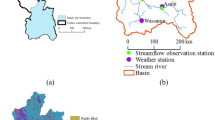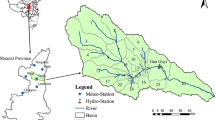Abstract
Spatial planning for sustainable water resources development requires precise information on the local potential for providing water yield in a watershed. For water resource conservation, we analyzed spatial and temporal patterns of hydrological provision ecosystem services in the upper Teshio watershed of northernmost Japan. The Soil and Water Assessment Tool (SWAT) was applied to simulate hydrologic processes and determine parameters affecting the water cycle. The spatial increase of water yield at flat area near river channel in winter was explained by low field capacity of soil water, absence of water uptake by crops and gentle topography. The spatial patterns of snowmelt and rainfall were important drivers of the spatial pattern in water yield during other periods. The zonation model was applied to investigate dynamic changes in spatial conservation prioritization of hydrological provision ecosystem services, according to simulated water yields in February, April and October. The results showed that the conservation priority ranking dynamically changed spatially and temporally. Our economic assessment of hydrological provisioning services (irrigation, electricity production and household usage) indicated that the spatial pattern of the priority for water resources was different from that of economic value of the provisioning services. Our results indicated that a combination of hydrologic and cost zonation models would improve sustainable management planning of water resources and their hydrological ecosystem services have great spatiotemporal fluctuation.






Similar content being viewed by others
References
Abbaspour KC, Johanson A, van Genuchten MT (2004) Estimating uncertain flow and transport parameters using a sequential uncertainty fitting procedure. Vadose Zone J 3(4):1340–1352
Abbaspour KC, Yang J, Maximov I, Siber R, Mieleitner J, Zobrist J, Srinivasan R (2007) Modelling hydrology and water quality in the pre-alpine/alpine Thur watershed using SWAT. J Hydrol 333(2-4):413–430
Anderson BJ, Armsworth PR, Eigenbrod F et al (2009) Spatial covariance between biodiversity and other ecosystem service priorities. J Appl Ecol 46:888–896
Arnold JG, Allen PM (1996) Estimating hydrologic budgets for three Illinois watersheds. J Hydrol 176:57–77
Arnold JG, Srinivasan R, Muttiah RS, Williams JR (1998) Large area hydrologic modeling and assessment part I: Model development. J Am Water Resour Assoc 34(1):73–89
Arnold JG, Muttiah RS, Srinivasan R, Allen PM (2000) Regional estimation of base flow and groundwater recharge in the Upper Missippi river basin. J Hydrol 227:21–40
Arponen A, Cabeza M, Eklund J, Kujala H, Lehtomäki J (2010) Costs of integrating economics and conservation planning. Conserv Biol 24(5):1198–1204
Betrie GD, Mohamed YA, Griensven AV, Srinivasan R (2011) Sediment management modeling in the Blue Nile Basin using SWAT model. Hydrol Earth Syst Sci 15:807–818
Brown AE, Zhang L, McMahon TA, Western AW, Vertessy RA (2005) A review of paired catchment studies for determining changes in water yield resulting from alterations in vegetation. J Hydrol 310:28–61
Cabeza M, Moilanen A (2006) Replacement cost: A practical measure of site value for cost-effective reserve planning. Biol Conserv 132:336–342
Chan KMA, Shaw MR, Cameron DR, Underwoood EC, Daily GC (2006) Conservation planning for ecosystem services. PLoS Biology 4(11):e379, 2138–2152
Chan KMA, Hoshizaki L, Klinkenberg (2011) Ecosystem services in conservation planning: Targeted benefits vs. co-benefits or costs? PLoS Biology 6 (9):e24378, 1–14
Costanza R, Ralph d’ A, de Groot R et al (1997) The value of the world’s ecosystem services and natural capital. Nature 387:253–259
Gordon A, Simondson D, White M, Moilanen A, Bekessy SA (2009) Integrating conservation planning and landuse planning in urban landscapes. Lands Urban Plan 91(4):183–194
Gosain AK, Rao S, Basuray, (2006) Climate change impact assessment on hydrology of Indian river basins. Curr Sci 90(3):346–353
Guo ZW, Xiao XM, Li DM (2000) An assessment of ecosystem services: water flow regulation and hydroelectric power production. Ecol Appl 10(3):925–936
Ileva NY, Shibata H, Satoh F, Sasa K, Ueda (2009) Relationship between the riverine nitrate-nitrogen concentration and the land use in the Teshio River watershed, North Japan. Sustain Sci 4:189–198. doi:10.1007/s 11625-009-0081-5
IUSS Working group WRB (2006) World reference base for soil resources 2006. World soil rewources reports no. 103, FAO, Rome
Jha MK (2011) Evaluating hydrologic response of an agriculture watershed for watershed analysis. Water 3:604–617. doi:10.3390/w3020604
Kaplowitz MD, Lupi F, Arreola O (2012) Local markets for payments for environmental services: Can small rural communities self-finance watershed protection? Water Resour Manag 26:3689–3740
Katsuyama M, Shibata H, Yoshioka T, Yoshida T, Ogawa A, Ohte N (2009) Applications of a hydro-biogeochemical model and long-term simulations of the effects of logging in forested watersheds. Sustain Sci 4:189–198
Kremen C, Cameron A, Moilanen A et al (2008) Aligning conservation priorities across Taxa in Madagascar with high-resolution planning tools. Science 320(5873):222–226
Leathwick J, Moilanen A, Francis M, Elith J, Taylor P, Julian K, Hastie T, Duffy C (2008) Novel methods for the design and evaluation of marine protected areas in offshore waters. Conserv Lett 1(2):91–102
Marshall E, Randhir T (2008) Effect of climate change on watershed system: a regional analysis. Climatic Change 89: 263:280
Mikusinski G, Pressey RL, Edenius L, Kujala H, Moilanen A, Niemelä J, Ranius T (2007) Conservation Planning in Forest Landscape of Fennoscandia and an approach to the challenge of countdown 2010. Conserv Biol 21(6):1445–1454
Ministry of Land, Infrastructure and Transport, Japan (1993) Investigation reports on main drainage system of upstream Teshio watershed, http://nrb-www.mlit.go.jp/kokjo/inspect/landclassification/water/
Moilanen A (2007) Landscape zonation, benefit functions and target-based planning: Unifying reserve selection strategies. Biol Conserv 134(4):571–579
Moilanen A (2008) Two paths to a suboptimal solution once more about optimality in reserve selection. Biol Conserv 141(7):1919–1923
Moilanen A, Kujala H (2008) The zonation conservation planning framework and software v. 2.0: User Manual. Edita, Helsinki, www. Helsinki.fi/BioScience/ConsPlan
Moilanen A, Franco AMA, Early RI, Fox R, Wintle B, Thomas CD (2005) Prioritizing multiple-use landscapes for conservation: Methods for large Multi-species planning problems. Proc R Soc B 272:1885–1891
Moilanen A, Arponen A, Stockland JN, Cabeza M (2009) Assessing replacement cost of conservation areas: How does habitat loss influence priorities? Biol Conserv 142:575–585
Naidoo R, Adamowicz WL (2005) Modeling opportunity costs of conservation in transitional landscapes. Conserv Biol 20(2):490–500
Naidoo R, Ricketts TH (2006) Mapping the economic costs and benefits of conservation. PLoS Biology 4(11): e360, 2153–2164
Naidoo R, Balmford A, Ferraro PJ, Polasky S, Ricketts TH, Rouget M (2006) Integrating economic costs into conservation planning. Trends Ecol Evol 21(12):681–687
Narasimhan B, Srinivasan R, Arnold JG, Di Lusio M (2005) Estimation of long-term soil moisture using distributed parameter hydrologic model and verification using remotely sensed data. Trans ASAE 48(3):1101–1113
Nash JE, Sutcliffe JV (1970) River flow forecasting through conceptual models. Part I- A discussion of principles. J Hydrol 10(3):282–290
Nelson E, Mendoza G, Regetz J et al (2009) Modeling multiple ecosystem services, biodiversity conservation, commodity production, and tradeoffs at landscape scales. Front Ecol Environ 7(1):4–11
Pachepsky YA, Timlin DJ, Rawls WJ (2001) Soil water retention as related to topographic variables. Soil Sci Am J 65:1787–1795
Ratto M, Young PC, Romanowicz R, Pappenberge F, Saltelli A, Pagano A (2007) Uncertainty, sensitivity analysis and the role of data based mechanistic modeling in hydrology. Hydrol Earth Syst Sci Discuss 11:1249–1266
Rodriguez HG, Popp J, Maringanti C, Chanbey I (2011) Selection and placement of best management practices used to reduce water quality degradation in Lincoln Lake watershed. Water Resour Res 47, W01507
Salerno F, Tartari G (2009) A coupled approach of surface hydrological modelling and Wavelet Analysis for understanding the baseflow components of river discharge in karst environments. J Hydrol 376(1-2):295–306
Schröter D, Cramer W, Leemans R et al (2005) Ecosystem services supply and vulnerability to global change in Europe. Science 310(5752):1333–1337
Schuol J, Abbaspour KC, Yang H, Srinivasan R, Zehnder AJB (2008) Modeling blue and green water availability in Africa. Water Resour. Res 44(7): W07406, 1–18
Somura H, Arnold J, Hoffman D, Takeda I, Mori T, Luzio MD (2009) Impact of climate change on the Hii River basin and salinity in Lake Shinji: A case study using the SWAT model and a regression curve. Hydrol Process 23:1887–1900
Soulis KX, Valiaantzas JD (2013) Identification of the SCS-CN parameter spatial distribution using rainfall-runoff data in heterogeneous watersheds. Water Resour Manag 27:1737–1749
Stewart RRM, Possingham HP (2005) Efficiency, costs and trade-offs in marine reserve system design. Environ Model Assess 10(3):203–213
Tani M (1997) Runoff gegeration processes estimated from hydrological observations on a steep forested hillslope with a thin soil layer. J Hydrol 200:84–109
Thampi SG, Raneesh KY, Surya TV (2010) Influence of scale on SWAT model calibration for streamflow in a river basin in the humid tropics. Water Resour Manag 24:4567–4578
Tortajada C, Joshi YK (2013) Water demand management in Singapore: Involving the public. Water Resour Manag 27:2729–2746
Tsukamoto Y, Ohta T (1988) Runoff process on a steep forested slope. J Hydrol 102:165–178
van Griensven A, Meixner T, Grunwald S, Bishop T, Diluzio M, Srinivasan R (2006) A global sensitivity analysis tool for the parameters of multi-variable catchment models. J Hydrol 324(1-4):10–23
Wallace KJ (2007) Classification of ecosystem services: problems and solutions. Biol Conserv 139(3-4):235–246
Wang X, Melesse AM (2005) Evaluation of the SWAT model’s snowmelt hydrology in a northwestern Minnesota watershed. Trans ASAE 48(4):1–18
Yang J, Reichert P, Abbaspour KC, Yang H (2007) Hydrological modeling of the Chaohe basin in China: Statistical model for formulation and Bayesian inference. J Hydrol 340(3-4):167–182
Acknowledgments
This study was partly supported by a scholarship from the China Scholarship Council. The work was conducted under the Program for Risk Information on Climate Change (SOUSEI Program), supported by the Ministry of Education, Culture, Sports, Science and Technology of Japan (MEXT). We thank the management office of Uryu Dam, Hokkaido Electric Co., Ltd., for providing data on water inflow to the Teshio River. We also are grateful for Drs. Makoto Ooba and Kiichiro Hayashi provided useful comments to initial draft of the paper.
Author information
Authors and Affiliations
Corresponding author
Rights and permissions
About this article
Cite this article
Fan, M., Shibata, H. Spatial and Temporal Analysis of Hydrological Provision Ecosystem Services for Watershed Conservation Planning of Water Resources. Water Resour Manage 28, 3619–3636 (2014). https://doi.org/10.1007/s11269-014-0691-2
Received:
Accepted:
Published:
Issue Date:
DOI: https://doi.org/10.1007/s11269-014-0691-2




